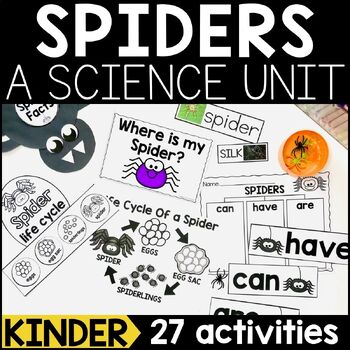Spiders Kindergarten Science Unit | Spider Life Cycle, Parts of a Spider, & More
- Zip
What educators are saying
Also included in
- Engage your class in exciting, hands-on learning as you teach them all about holiday animals! These units are perfect for science in Kindergarten, First Grade, and Second Grade classrooms. With this bundle you'll get 7 week-long units to teach during the holidays. Your students will love the interacPrice $36.00Original Price $59.00Save $23.00
- Delve into the fascinating world of animals with our expanding Animal Study MEGA BUNDLE. Each weeklong unit features captivating PowerPoint lessons, engaging student activities, and paired worksheets. Perfect for year-round use, these resources offer endless learning adventures! Don't miss out—purchPrice $79.00Original Price $180.00Save $101.00
- Engage your class in exciting hands-on learning experiences all year long with this Kindergarten Science Bundle. This kindergarten science curriculum resource contains 52 week-long science units and 12 months worth of seasonal/holiday science experiments. This bundle is packed with activities and inPrice $120.00Original Price $617.89Save $497.89
Description
Learning all about spiders is so much fun! This exciting spider unit is a great resource to engage your learners during spooky season or when studying insects and arachnids in the spring. This weeklong science unit is filled with exciting hands-on learning experiences and student activity pages. This unit was created with Kindergarten in mind, but can be adapted for use in Pre-K, First Grade, and Second Grade classrooms.
Your students will learn all about spiders, their life cycle, their characteristics, and countless spider facts to share with their friends and family.
With this unit you’ll have everything you need and more to teach your students all about spiders. Click on “View Preview” to get a better idea of what you’ll get!
THIS SPIDER UNIT IS INCLUDED IN OUR:
WHAT'S INCLUDED IN THIS UNIT:
- Unit Overview Lesson Plans
- At-Home Letter
- Teacher Guide Science Center & Stem Ideas
- Science Questions
- Book, Video, and Song Lists Spider Facts Posters
- Spider Emergent Reader
- Question of the Week
- Spider Can-Have-Are Activity
- Parts of a Spider Posters
- Parts of a Spider Worksheets
- Spider Life Cycle Posters
- Spider Life Cycle Worksheets
- Spider Fact or Fiction Activity
- Spider Fact or Research Craft
BONUS MATERIALS
- Writing Center
- Definition Posters
- Word Wall
- Circle Map
- Types of Spiders Posters
- Fingerplay
- Positional Words Emergent Reader
- Spider Bingo
- Life Cycle of a Spider Hat
- Spider Math Centers
- Marble Spider Web Craft
- Glitter Spider Web Craft
- Spider STEM Activities
- Spiders and Insects Posters
- Spiders and Insects Worksheets
- Spiders and Insects Sort
- Spiders and Insects Sort Worksheet
WAYS TO USE THIS UNIT
- Use the Spider Facts PowerPoint to open your daily mini-lesson. Gather your students for a quick, whole group lesson to kick off each day of learning. The slideshow includes 11 interesting spider facts sure to excite your students. There is also a Spiders and Insects PowerPoint that is great to use for comparing and contrasting.
- Students will love completing their research craft. Try incorporating the this or other crafts from this unit in a science center. Your students will have so much fun collaborating with their friends while learning all about spiders.
- This unit is filled with student activity pages. Use the many printables and emergent readers for independent work or partner practice. Not enough time during your science block? We get that! Create cross curricular connections when you incorporate these nonfiction learning materials in your reading and writing block.
- Provide closure to each day's learning by using the songs and videos that are linked in this product. You won’t ever have to go searching for fun ways to engage your students when you purchase this product!
WHAT TEACHERS ARE SAYING:
⭐⭐⭐⭐⭐ "My students enjoyed using this resource for our spider unit of study. I highly recommend this seller, I have used many resources created by her."
⭐⭐⭐⭐⭐ "This was an incredible resource and now i am going to buy the bundle. So much information and materials for all disabilities and for reg ed. LOVE THE SELLER!"
⭐⭐⭐⭐⭐ "We did a whole two week unit on Spiders and there were SO many amazing activities to do in this pack. Very engaging, love the non-fiction images. I highly recommend!"
CHECK OUT THESE RELATED PRODUCTS:
LET’S CONNECT
➡️Subscribe to our weekly newsletter where you'll receive freebies and be the first to know about sales and new products.
If you have any questions or need help, please email us at hello@adabofgluewilldo.com.
Copyright © A Dab of Glue Will Do, LLC








